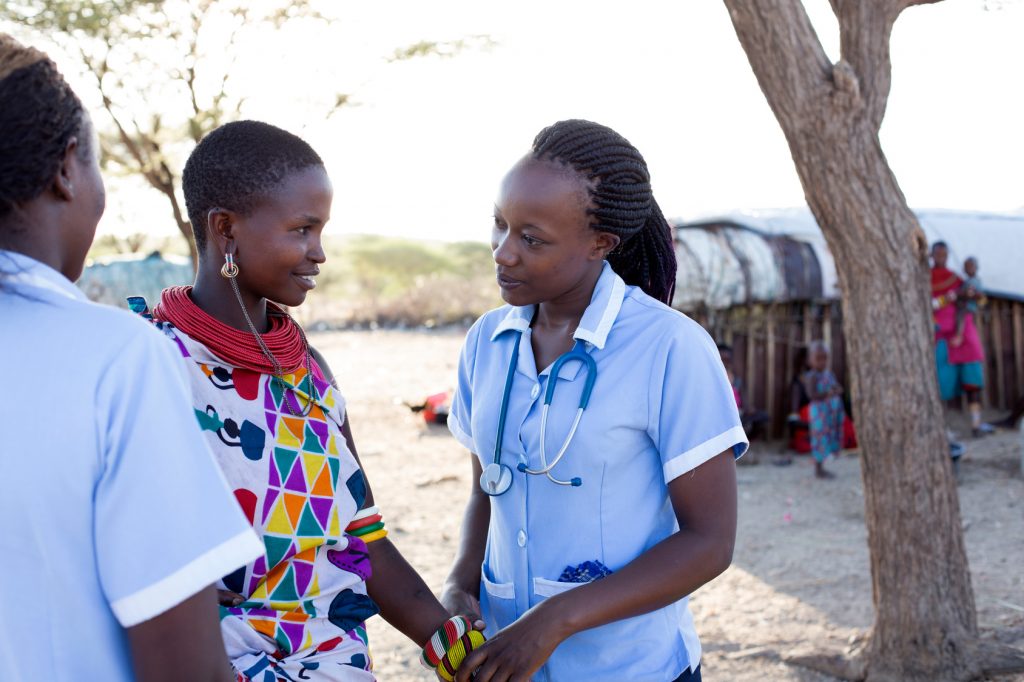
Context
Cervical cancer is the leading cause of all cancer deaths in Kenya and the second most common cancer in women. The Kenyan Ministry of Health had a national rollout of the HPV vaccine in October 2019, targeting 10-year-old girls. The vaccine is now available free of charge to girls ages 10 – 14 years alongside other routine vaccines through over 9,000 public, private, non-government, and faith-based health facilities. The National Vaccines & Immunization Program Kenya continues to make efforts to increase HPV vaccination rates.
Project
To increase the uptake of the HPV vaccine in Kenya a behavioural research study was led by the Busara Center for Behavioural Economics aimed at providing an evidence-based, locally effective, social and behavioural change communications solution. The scope of this study was three-fold. First, the formative study explored behavioural, structural, and environmental barriers and enablers to the uptake of the HPV vaccine among parents of adolescent girls across Kenya by interviewing and observing parents in Nairobi and Nakuru. Second, three communication intervention packages were co-designed using three behavioural themes to address prioritised barriers and integrate behavioural levers for parents. Finally, the study experimentally tested the three intervention packages with 800 parents and recommended the most effective behavioural theme and interventions to drive optimal uptake of the HPV vaccine. Read the full research report here.

Behavioural Assessment
The behavioural assessment included identifying key barriers and enablers for parents in choosing to vaccinate their daughters.
Barriers to HPV vaccination uptake
Lack of information: The study found that many parents were either not aware of the vaccine or lacked actionable information for decision-making. This led parents to falsely associate a cost with the vaccine and believe prevalent myths and misconceptions. The lack of information left parents feeling underconfident in making an informed decision to vaccinate their daughters against HPV.
Social stigma and social norms: The study found high levels of social stigma associated with any discussions about sex and health topics related to sex. Since HPV infections are primarily, though not exclusively, transmitted through skin-to-skin contact during sex, there was likely low motivation and even reluctance in parents and communities to engage in conversations about HPV vaccination to prevent HPV infections. This contributed to lower acceptance and uptake of HPV vaccine.
Enablers encouraging HPV vaccination uptake
Trusted sources of health-related information: Parents were found to trust the government, healthcare workers, and teachers for health-related information. Parents believed that the government could not approve a product that would cause harm to its people and therefore held an overwhelming trust in government-provided programs and services. Parents viewed healthcare workers (doctors, nurses, and/or community health workers and volunteers) as educated experts and trusted them to recommend essential health services to them as well as to clarify their queries on healthcare services. Among the three – government, healthcare workers, and teachers – parents reported the most trust in healthcare workers for health-related information.
Parents’ sense of responsibility: Parents reported feeling a sense of responsibility for their children’s health, even when they were married or living separately. Further, they preferred prevention over cure because they thought prevention is cheaper than curative medicine and that prevention is important to maintain health rather than waiting for a child to become sick before seeking care, as this could lead to death.
Fear of cancer and of consequences if unvaccinated: Parents reported a high level of awareness and fear of cancer. Further, parents reported a fear of negative consequences from a child not getting the vaccine. The most common fear reported was of children becoming disabled due to non-vaccination. The majority of parents in our sample also believed that not getting their daughter an important vaccine could be fatal for her and about half believed that some parents put other children at risk by delaying getting their own child vaccinated.
Behavioural Design
Co-designing solutions to address barriers
We designed a communications package that directly addressed parental barriers to HPV vaccine uptake. A design workshop was held with key stakeholders from the ministry of health, paediatric society, cancer organisations, community organisations, and academia to generate ideas for solutions that were later refined. The communications package focused on two key aspects:
- Behavioural framing of messages to parents
- The messenger or endorser of the messages
Behavioural framing
Three behavioural themes or framings were finalised based on barriers and enablers for parents:
- Fear of cancer: Messages can persuade people to adopt a behaviour by arousing fear of potential danger and consequences if they fail to do so.
- Gain/Aspirations: Making positive gains salient by emphasising the benefits of taking a certain action can make people respond by taking that action.
- Social norms: Normalising a recommended behaviour can reduce indecision and lead to greater adoption of that behaviour.
The effect of a health care professional’s recommendation on parental knowledge and intent to vaccinate was also studied along with the effect of the gender of a health care professional.
Solutions
We created corresponding messages and testimonials to compare the three behavioural themes: Fear, gain/aspirations, and social norms. The messages were presented to parents in the form of a poster and an interactive SMS campaign comprised of the key message, frequently asked questions, and stories. Testimonials were presented in the form of audio clips.
To assess the effect of the messenger on parents’ intentions to vaccinate, posters were presented to parents featuring a medical practitioner or health care professional’s recommendation.
Evaluating Solutions
Behavioural frames were experimentally tested with a total of 800 parents randomly assigned to four groups: control, fear, aspirations/gains, and social norms. A poster with information about the HPV vaccine was sent to participant phones and they were engaged through the interactive SMS campaign over the course of a week. At the end of the week, participants were called for an endline phone survey where we captured primary outcome measures including:
- Self-reported likelihood to vaccinate
- HPV knowledge
- Trust in the information provided
The effect of the health care professional’s recommendation was experimentally tested with a total of 600 parents who were randomly assigned to three groups: control (no messenger included with the recommendation), a recommendation from a female doctor, and a recommendation from a male doctor. Each participant received a poster recommending they get their daughter the HPV vaccine.
Participants received an endline survey which assessed two primary outcomes: self-reported likelihood to vaccinate and perceived vaccine safety.
Results
Message framing
Our evaluation study found that gain/aspirations framing was effective in increasing parental trust in the vaccine and motivating parents to know more about the vaccine. Parents saw the HPV vaccine as a means to protect their daughters’ futures. Fear framing yielded negative results in terms of intentions to vaccinate and reduced the likelihood of parents trusting the information. Social norms did not have either a positive or negative effect.
Note that none of the three message framings in our study changed parent intent to vaccinate.
Messenger
The study found that endorsements of the HPV vaccine from doctors were effective at strengthening parent intentions to get their daughters the HPV vaccine and at strengthening parent perceptions around the safety of the vaccine. No difference was found between recommendations coming from a male doctor or a female doctor.
Delivery of message
SMS messaging did not test successfully.
Translating Insights into Action
Based on the research, we recommend the following as part of future HPV vaccine uptake initiatives in Kenya:
- Use positive or aspirations framing: Initiatives should link the HPV vaccine to the aspirations of parents to protect their daughters’ futures.
- Communicate doctors’ support for the HPV vaccine: Parents’ trust in doctors and other health workers should be highlighted by HPV vaccine initiatives targeting parents.
- Understand the end user and their environment: Identify channels of communication to reach your audience. SMS may not be the best way to reach lower socio-economic populations.
- Framing of vaccine as cancer prevention: Frame the HPV vaccine as a cancer-preventing rather than an HPV-preventing vaccine for greatest impact.
- Deliver solutions via community health workers: As trusted members of the community, community health volunteers, extension workers, and assistants have important roles in increasing the uptake of HPV vaccine.
Additional research to document community health workers’ current tools and information sources, understand how they interact with parents, and their capacities to motivate parents can be found here.
